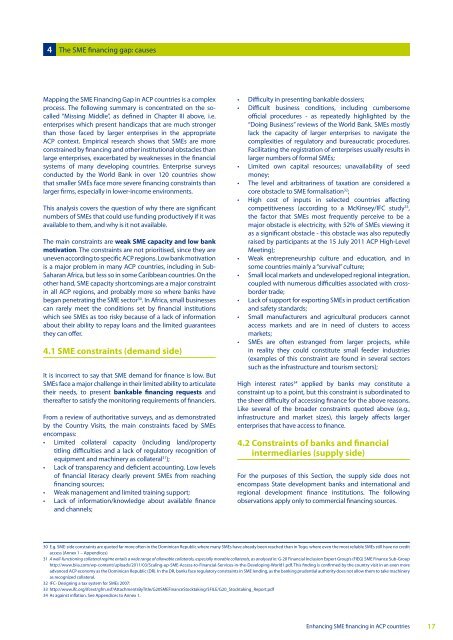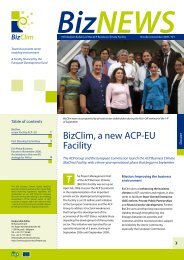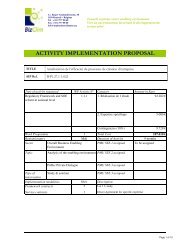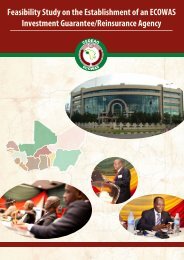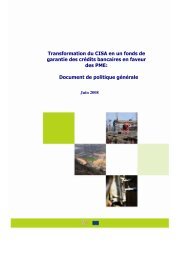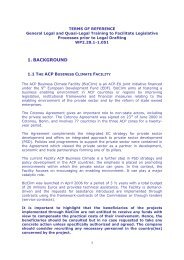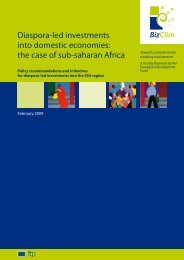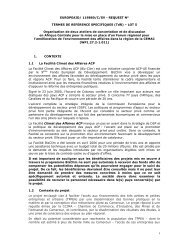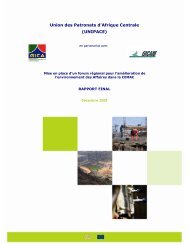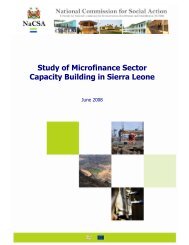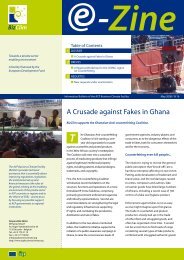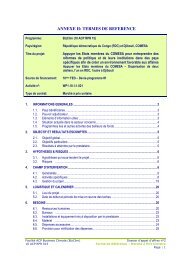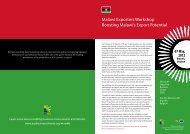Enhancing smE financing in acp countries - ACP Business Climate
Enhancing smE financing in acp countries - ACP Business Climate
Enhancing smE financing in acp countries - ACP Business Climate
Create successful ePaper yourself
Turn your PDF publications into a flip-book with our unique Google optimized e-Paper software.
4<br />
The sme <strong>f<strong>in</strong>anc<strong>in</strong>g</strong> gap: causes<br />
Mapp<strong>in</strong>g the SME F<strong>in</strong>anc<strong>in</strong>g Gap <strong>in</strong> <strong>ACP</strong> <strong>countries</strong> is a complex<br />
process. The follow<strong>in</strong>g summary is concentrated on the socalled<br />
“Miss<strong>in</strong>g Middle”, as def<strong>in</strong>ed <strong>in</strong> Chapter III above, i.e.<br />
enterprises which present handicaps that are much stronger<br />
than those faced by larger enterprises <strong>in</strong> the appropriate<br />
<strong>ACP</strong> context. Empirical research shows that SMEs are more<br />
constra<strong>in</strong>ed by <strong>f<strong>in</strong>anc<strong>in</strong>g</strong> and other <strong>in</strong>stitutional obstacles than<br />
large enterprises, exacerbated by weaknesses <strong>in</strong> the f<strong>in</strong>ancial<br />
systems of many develop<strong>in</strong>g <strong>countries</strong>. Enterprise surveys<br />
conducted by the World Bank <strong>in</strong> over 120 <strong>countries</strong> show<br />
that smaller SMEs face more severe <strong>f<strong>in</strong>anc<strong>in</strong>g</strong> constra<strong>in</strong>ts than<br />
larger firms, especially <strong>in</strong> lower-<strong>in</strong>come environments.<br />
This analysis covers the question of why there are significant<br />
numbers of SMEs that could use fund<strong>in</strong>g productively if it was<br />
available to them, and why is it not available.<br />
The ma<strong>in</strong> constra<strong>in</strong>ts are weak SME capacity and low bank<br />
motivation. The constra<strong>in</strong>ts are not prioritised, s<strong>in</strong>ce they are<br />
uneven accord<strong>in</strong>g to specific <strong>ACP</strong> regions. Low bank motivation<br />
is a major problem <strong>in</strong> many <strong>ACP</strong> <strong>countries</strong>, <strong>in</strong>clud<strong>in</strong>g <strong>in</strong> Sub-<br />
Saharan Africa, but less so <strong>in</strong> some Caribbean <strong>countries</strong>. On the<br />
other hand, SME capacity shortcom<strong>in</strong>gs are a major constra<strong>in</strong>t<br />
<strong>in</strong> all <strong>ACP</strong> regions, and probably more so where banks have<br />
began penetrat<strong>in</strong>g the SME sector 30 . In Africa, small bus<strong>in</strong>esses<br />
can rarely meet the conditions set by f<strong>in</strong>ancial <strong>in</strong>stitutions<br />
which see SMEs as too risky because of a lack of <strong>in</strong>formation<br />
about their ability to repay loans and the limited guarantees<br />
they can offer.<br />
4.1 SME constra<strong>in</strong>ts (demand side)<br />
It is <strong>in</strong>correct to say that SME demand for f<strong>in</strong>ance is low. But<br />
SMEs face a major challenge <strong>in</strong> their limited ability to articulate<br />
their needs, to present bankable <strong>f<strong>in</strong>anc<strong>in</strong>g</strong> requests and<br />
thereafter to satisfy the monitor<strong>in</strong>g requirements of f<strong>in</strong>anciers.<br />
From a review of authoritative surveys, and as demonstrated<br />
by the Country Visits, the ma<strong>in</strong> constra<strong>in</strong>ts faced by SMEs<br />
encompass:<br />
• Limited collateral capacity (<strong>in</strong>clud<strong>in</strong>g land/property<br />
titl<strong>in</strong>g difficulties and a lack of regulatory recognition of<br />
equipment and mach<strong>in</strong>ery as collateral 31 );<br />
• Lack of transparency and deficient account<strong>in</strong>g. Low levels<br />
of f<strong>in</strong>ancial literacy clearly prevent SMEs from reach<strong>in</strong>g<br />
<strong>f<strong>in</strong>anc<strong>in</strong>g</strong> sources;<br />
• Weak management and limited tra<strong>in</strong><strong>in</strong>g support;<br />
• Lack of <strong>in</strong>formation/knowledge about available f<strong>in</strong>ance<br />
and channels;<br />
• Difficulty <strong>in</strong> present<strong>in</strong>g bankable dossiers;<br />
• Difficult bus<strong>in</strong>ess conditions, <strong>in</strong>clud<strong>in</strong>g cumbersome<br />
official procedures - as repeatedly highlighted by the<br />
“Do<strong>in</strong>g Bus<strong>in</strong>ess” reviews of the World Bank. SMEs mostly<br />
lack the capacity of larger enterprises to navigate the<br />
complexities of regulatory and bureaucratic procedures.<br />
Facilitat<strong>in</strong>g the registration of enterprises usually results <strong>in</strong><br />
larger numbers of formal SMEs;<br />
• Limited own capital resources; unavailability of seed<br />
money;<br />
• The level and arbitrar<strong>in</strong>ess of taxation are considered a<br />
core obstacle to SME formalisation 32 ;<br />
• High cost of <strong>in</strong>puts <strong>in</strong> selected <strong>countries</strong> affect<strong>in</strong>g<br />
competitiveness (accord<strong>in</strong>g to a McK<strong>in</strong>sey/IFC study 33 ,<br />
the factor that SMEs most frequently perceive to be a<br />
major obstacle is electricity, with 52% of SMEs view<strong>in</strong>g it<br />
as a significant obstacle - this obstacle was also reputedly<br />
raised by participants at the 15 July 2011 <strong>ACP</strong> High-Level<br />
Meet<strong>in</strong>g);<br />
• Weak entrepreneurship culture and education, and <strong>in</strong><br />
some <strong>countries</strong> ma<strong>in</strong>ly a “survival” culture;<br />
• Small local markets and undeveloped regional <strong>in</strong>tegration,<br />
coupled with numerous difficulties associated with crossborder<br />
trade;<br />
• Lack of support for export<strong>in</strong>g SMEs <strong>in</strong> product certification<br />
and safety standards;<br />
• Small manufacturers and agricultural producers cannot<br />
access markets and are <strong>in</strong> need of clusters to access<br />
markets;<br />
• SMEs are often estranged from larger projects, while<br />
<strong>in</strong> reality they could constitute small feeder <strong>in</strong>dustries<br />
(examples of this constra<strong>in</strong>t are found <strong>in</strong> several sectors<br />
such as the <strong>in</strong>frastructure and tourism sectors);<br />
High <strong>in</strong>terest rates 34 applied by banks may constitute a<br />
constra<strong>in</strong>t up to a po<strong>in</strong>t, but this constra<strong>in</strong>t is subord<strong>in</strong>ated to<br />
the sheer difficulty of access<strong>in</strong>g f<strong>in</strong>ance for the above reasons.<br />
Like several of the broader constra<strong>in</strong>ts quoted above (e.g.,<br />
<strong>in</strong>frastructure and market sizes), this largely affects larger<br />
enterprises that have access to f<strong>in</strong>ance.<br />
4.2 Constra<strong>in</strong>ts of banks and f<strong>in</strong>ancial<br />
<strong>in</strong>termediaries (supply side)<br />
For the purposes of this Section, the supply side does not<br />
encompass State development banks and <strong>in</strong>ternational and<br />
regional development f<strong>in</strong>ance <strong>in</strong>stitutions. The follow<strong>in</strong>g<br />
observations apply only to commercial <strong>f<strong>in</strong>anc<strong>in</strong>g</strong> sources.<br />
30 E.g. SME-side constra<strong>in</strong>ts are quoted far more often <strong>in</strong> the Dom<strong>in</strong>ican Republic where many SMEs have already been reached than <strong>in</strong> Togo, where even the most reliable SMEs still have no credit<br />
access (Annex 1 – Appendices)<br />
31 A well-function<strong>in</strong>g collateral regime entails a wide range of allowable collaterals, especially movable collaterals, as analysed <strong>in</strong>: G-20 F<strong>in</strong>ancial Inclusion Expert Group’s (FIEG) SME F<strong>in</strong>ance Sub-Group<br />
http://www.biia.com/wp-content/uploads/2011/03/Scal<strong>in</strong>g-up-SME-Access-to-F<strong>in</strong>ancial-Services-<strong>in</strong>-the-Develop<strong>in</strong>g-World1.pdf. This f<strong>in</strong>d<strong>in</strong>g is confirmed by the country visit <strong>in</strong> an even more<br />
advanced <strong>ACP</strong> economy as the Dom<strong>in</strong>ican Republic (DR). In the DR, banks face regulatory constra<strong>in</strong>ts <strong>in</strong> SME lend<strong>in</strong>g, as the bank<strong>in</strong>g prudential authority does not allow them to take mach<strong>in</strong>ery<br />
as recognized collateral.<br />
32 IFC- Design<strong>in</strong>g a tax system for SMEs 2007:<br />
33 http://www.ifc.org/ifcext/gfm.nsf/AttachmentsByTitle/G20SMEF<strong>in</strong>anceStocktak<strong>in</strong>g/$FILE/G20_Stocktak<strong>in</strong>g_Report.pdf<br />
34 As aga<strong>in</strong>st <strong>in</strong>flation. See Appendices to Annex 1.<br />
<strong>Enhanc<strong>in</strong>g</strong> SME <strong>f<strong>in</strong>anc<strong>in</strong>g</strong> <strong>in</strong> <strong>ACP</strong> <strong>countries</strong><br />
17


